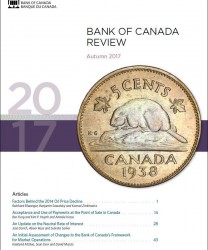Bank of Canada Review - Autumn 2017
Is shale oil production in the United States a factor in the 2014 oil price decline? Which methods of payment are commonly accepted by merchants in Canada? Bank researchers share their insights on these topics. They also provide an update on the neutral rate of interest as well as on changes to the Bank’s operational framework for market operations.
The Bank of Canada Review is published twice a year. Articles undergo a thorough review process. The views expressed in the articles are those of the authors and do not necessarily reflect the views of the Bank.
The contents of the Review may be reproduced or quoted, provided that the authors and the publication, with its date, are specifically cited as the source.
